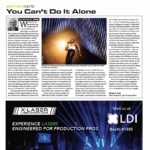Are you tired of hearing about safety yet? I hope not. It has always been important, but it lurched front and center for our industry during the stormy 2011 summer touring season, and it won’t go away any time soon. Being safe ensures that you’ll make it to the next gig. Sure, you may overlook some minimal safety concern and still be fine. Honestly, who hasn’t forgotten a safety cable now and then? It’s a slight oversight, and may not be the end of the world. That is, until something else fails, and there is a 20-plus-pound dead weight traveling 120 mph towards the deck. Are you wearing a hard hat?
What other “small” thing have you missed? It’s all these little things that add up and can eventually lead to something much more serious. I am not out to scare you into a chronic state of paranoia, but we do work in hazardous conditions. We need to be mindful, and make sure others are as well. The old adage, “Do as I say, and not as I do” just won’t cut it any more.
Not Just for Reading Pleasure
In early February, The Event Safety Alliance (ESA) made available their 273-page Event Safety Guide for public review and comment. The PDF document is the ESA’s draft of a North American version of the U.K.’s compendium of safe practices for the entertainment industry, also titled the Event Safety Guide, and commonly known as “The Purple Guide.”
The ESA’s updates go beyond the orange-and-white color of the cover page. ESA has tapped into the knowledge and experience of industry veterans and leaders to update and supplement the guide for the U.S. and Canadian market and, as a work in progress, the guide is continuing to be shaped this year.
The ESA’s overall mission with the guide is not so much to come up with pleasurable leisure-time reading, but to prevent accidents that threaten life and limb. The goal is to do that by promoting a safety-first mentality shared by everyone working backstage, and to do that through easily-understood language about operational practices. The guide aims to provide these best practices for almost every type of entertainment and public event.
Uncle Sam is Watching
In light of the recent stage accidents here and around the world, the U.S. government has put our industry under the microscope. For years, we have been governed by common sense and an instinct for self-presevation. The ESA’s goal is to prove to government officials that we are still capable of providing a high level of safety without the need for oversight committees and bureaucratic red tape.
The ESA’s Event Safety Guide is a work in progress. There are plans for future discussions, education opportunities and outreach to spread the word that our industry means business and safety is our first priority.
Reading is the First Step
I will be honest here. The draft version of the Event Safety Guide is not as exciting as reading the latest Tom Clancy novel. At times, it may seem silly or redundant to read how to safely provide food and water at an event. But if you don’t have those basic needs met at a summer festival in triple digit temperatures, lives can be put in danger. Doesn’t seem as silly when you look at it in that light.
The Event Safety Guide is an important document to each and every individual working in the industry. It provides a methodology for providing the safest event. Following the guide may not guarantee a 100 percent safe environment and event, though adhering to its practices will leave less chance of an accident, injury or death.
Get Involved
The ESA has made the Event Safety Guide available as a free download on their website, eventsafetyalliance.org. ESA encourages everyone to register on the site, download, read and review the guide. They have framed an 180 day period for review of the guide before finalizing and publishing. If you are looking for a summer book to read, I personally encourage you to add the guide to the list and read it over and over again.
Find something that is questionable, lacking in necessary detail, or know of an even better practice than the “best practice” listed in the manual? Don’t keep it to yourself. Submit it to the ESA online, email, snail mail, send it by courier pigeon, any way that makes sense. Don’t let your notes fall to the same fate as my dictionary on my desk, collecting dust. Just make sure to submit it before the August 5, 2013 deadline. With all of us contributing and providing feedback, we can build a stronger guide and a safer working environment.
Watch Justin’s video on the March issue of PLSN at www.plsn.me/201303ednote.


